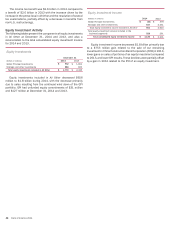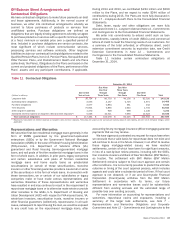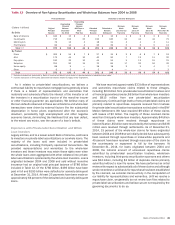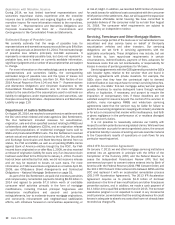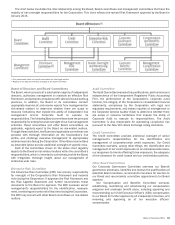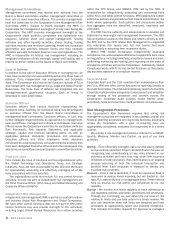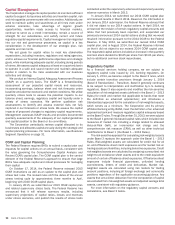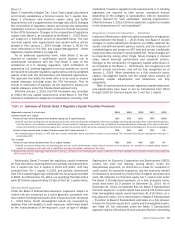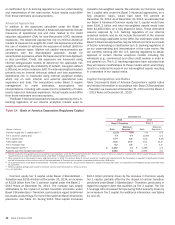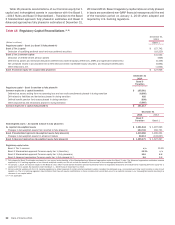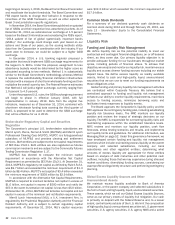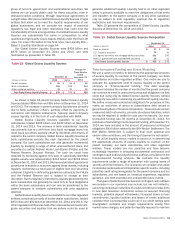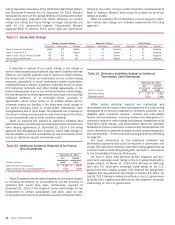Bank of America 2014 Annual Report Download - page 58
Download and view the complete annual report
Please find page 58 of the 2014 Bank of America annual report below. You can navigate through the pages in the report by either clicking on the pages listed below, or by using the keyword search tool below to find specific information within the annual report.56 Bank of America 2014
Capital Management
The Corporation manages its capital position to maintain sufficient
capital to support its business activities and maintain capital, risk
and risk appetite commensurate with one another. Additionally, we
seek to maintain safety and soundness at all times even under
adverse scenarios, take advantage of organic growth
opportunities, maintain ready access to financial markets,
continue to serve as a credit intermediary, remain a source of
strength for our subsidiaries, and satisfy current and future
regulatory capital requirements. Capital management is integrated
into our risk and governance processes, as capital is a key
consideration in the development of our strategic plan, risk
appetite and risk limits.
We set goals for capital ratios to meet key stakeholder
expectations, including investors, regulators and rating agencies,
and to achieve our financial performance objectives and strategic
goals, while maintaining adequate capital, including during periods
of stress. We assess capital adequacy at least on a quarterly basis
to operate in a safe and sound manner and maintain adequate
capital in relation to the risks associated with our business
activities and strategy.
We conduct an Internal Capital Adequacy Assessment Process
(ICAAP) on a quarterly basis. The ICAAP is a forward-looking
assessment of our projected capital needs and resources,
incorporating earnings, balance sheet and risk forecasts under
baseline and adverse economic and market conditions. We utilize
quarterly stress tests to assess the potential impacts to our
balance sheet, earnings, regulatory capital and liquidity under a
variety of stress scenarios. We perform qualitative risk
assessments to identify and assess material risks not fully
captured in our forecasts or stress tests. We assess the capital
impacts of proposed changes to regulatory capital requirements.
Management assesses ICAAP results and provides documented
quarterly assessments of the adequacy of our capital guidelines
and capital position to the Board or its committees.
The Corporation periodically reviews capital allocated to its
businesses and allocates capital annually during the strategic and
capital planning processes. For more information, see Business
Segment Operations on page 31.
CCAR and Capital Planning
The Federal Reserve requires BHCs to submit a capital plan and
requests for capital actions on an annual basis, consistent with
the rules governing the Comprehensive Capital Analysis and
Review (CCAR) capital plan. The CCAR capital plan is the central
element of the Federal Reserve’s approach to ensure that large
BHCs have adequate capital and robust processes for managing
their capital.
On October 17, 2014, the Federal Reserve released 2015
CCAR instructions as well as an update to the capital plan and
stress test rules. The revised rules shift the dates of the annual
stress testing cycle by approximately three months to April,
beginning with 2016 CCAR capital plans.
In January 2015, we submitted our 2015 CCAR capital plan
and related supervisory stress tests. The Federal Reserve has
announced that it will release summary results, including
supervisory projections of capital ratios, losses and revenues
under stress scenarios, and publish the results of stress tests
conducted under the supervisory adverse and supervisory severely
adverse scenarios in March 2015.
In January 2014, we submitted our 2014 CCAR capital plan
and received results in March 2014. Based on the information in
our January 2014 submission, the Federal Reserve advised that
it did not object to our 2014 capital actions. In April 2014, we
announced the revision of certain regulatory capital amounts and
ratios that had previously been reported, and suspended our
previously announced 2014 capital actions stating that we would
resubmit information pursuant to the 2014 CCAR to the Federal
Reserve. In May 2014, we submitted our revised 2014 CCAR
capital plan, and in August 2014, the Federal Reserve informed
us that it did not object to our revised 2014 CCAR capital plan.
The requested capital actions included an increase in the quarterly
common stock dividend to $0.05 per share from $0.01 per share,
but no additional common stock repurchases.
Regulatory Capital
As a financial services holding company, we are subject to
regulatory capital rules issued by U.S. banking regulators. On
January 1, 2014, we became subject to the Basel 3 rules, which
include certain transition provisions through January 1, 2019
(Basel 3 Standardized – Transition). Basel 3 generally continues
to be subject to interpretation and clarification by U.S. banking
regulators. Basel 3 also expands and modifies the risk-sensitive
calculation of risk-weighted assets (defined in the Basel 1 – 2013
Rules) for credit and market risk (applicable to banks that meet
the definition as advanced approaches); and introduces a
Standardized approach for the calculation of risk-weighted assets,
which serves as a minimum. The Corporation and its primary
affiliated banking entity, BANA, meet the definition of an advanced
approaches bank and measure regulatory capital adequacy based
on the Basel 3 rules. Through December 31, 2013, we were subject
to the Basel 1 general risk-based capital rules which included new
measures of market risk including a charge related to stressed
Value-at-Risk (VaR), an incremental risk charge and the
comprehensive risk measure (CRM), as well as other technical
modifications to Basel 1 (the Basel 1 – 2013 Rules).
The risk-sensitive approach for calculating risk-weighted assets
under Basel 3 replaces the approach under the Basel 1 – 2013
Rules. Risk-weighted assets are calculated for credit risk for all
on- and off-balance sheet credit exposures and for market risk on
trading assets and liabilities, including derivative exposures. Credit
risk-weighted assets are calculated by assigning a prescribed risk
weight to all on-balance sheet assets and to the credit equivalent
amount of certain off-balance sheet exposures. Off-balance sheet
exposures include financial guarantees, unfunded lending
commitments, letters of credit and derivatives. Market risk-
weighted assets are calculated using risk models for trading
account positions, including all foreign exchange and commodity
positions regardless of the applicable accounting guidance. Any
assets that are a direct deduction from the computation of capital
are excluded from risk-weighted assets and adjusted average total
assets, consistent with regulatory guidance.
For more information on the regulatory capital amounts and
calculations, see Basel 3 below.


